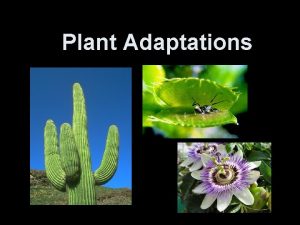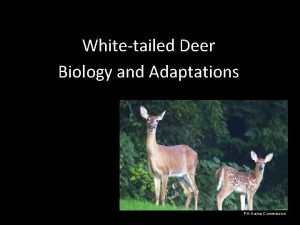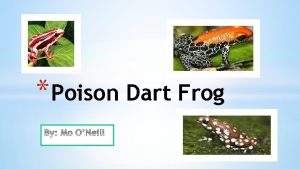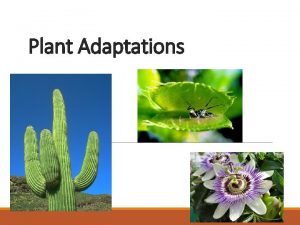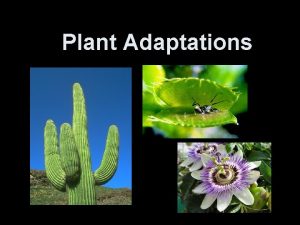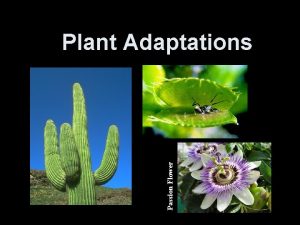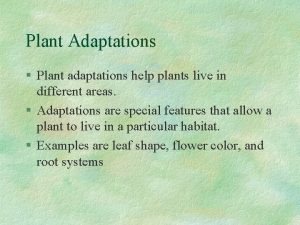Plant Adaptations Types of Adaptations Structural adaptations are
















- Slides: 16

Plant Adaptations

Types of Adaptations • Structural adaptations are the way something is built or made. • Behavioral adaptations are the way something acts naturally or by instinct.

Structural Adaptations • Adaptations to get food – Leaves and stems absorb energy from the sun.

Behavioral Adaptations • Adaptations to get food – Plants lean or grow towards the sun. – Roots grow down into soil. – Vines climb up trees to catch sunlight. – Plants like Venus fly trap, trap insects for food.

Structural Adaptations • Adaptations to get water and nutrients – Roots soak up water and nutrients from soil.

Behavioral Adaptations • Adaptations to get water and nutrients – Desert flowers can stay dormant for months, only coming to life when it rains.

Structural Adaptations • Adaptations for reproduction – Brightly colored flowers with nectar attract pollinators such as birds, bees and insects. – Sweet fruit attracts animals that spread seeds far away. – Some seeds are shaped to catch the wind.

Behavioral Adaptations • Adaptations for reproduction – Plants drop seeds to grow new offspring.

Structural Adaptations • Adaptations for defense – Spines and thorns protect plants from predators – Poison Ivy and Poison Oak have toxins that give predators a painful itchy rash

Plant Adaptations for different Biomes

Desert Adaptations – Small leaves or spines on desert plants conserve water. – Thick waxy skin holds in water. – Roots near the soils surface soak up rain water quickly before it evaporates.

Grassland Adaptations • Deep roots help plants survive prairie fires. • Narrow leaves lose less water than broad leaves. • Flexible stems bend in the wind.

Tundra Adaptations • Small plants grow close to the ground for warmth. • Dark colored flowers absorb heat from the sun. • Fuzzy stems provide protection from wind.

Rainforest Adaptations • Smooth, slippery bark keeps vines from killing trees. • Slide shaped leaves lets rain run off so fungus doesn’t grow on plants.

Temperate Forest Adaptations • Thick bark protects trees and dropping leaves in winter conserves water and nutrients during cold winters.

Water Adaptations • Flexible stems move with water currents. • Floating seeds spread offspring.
 Antigentest åre
Antigentest åre Poison oak adaptations
Poison oak adaptations Structural adaptation plant
Structural adaptation plant Whitetail deer adaptations
Whitetail deer adaptations Manatee structural adaptations
Manatee structural adaptations Coyote structural adaptations
Coyote structural adaptations Polar bears structural adaptations
Polar bears structural adaptations Poison dart frog adaptation
Poison dart frog adaptation Cheetahs physical adaptations
Cheetahs physical adaptations Living things meaning
Living things meaning How is a camel adapted to life in a desert
How is a camel adapted to life in a desert Duck structural adaptations
Duck structural adaptations Llama adaptations
Llama adaptations Unicellular organisms with cilia
Unicellular organisms with cilia Giraffes structural adaptations
Giraffes structural adaptations Structural consultants barking
Structural consultants barking Tigers adaptations
Tigers adaptations


